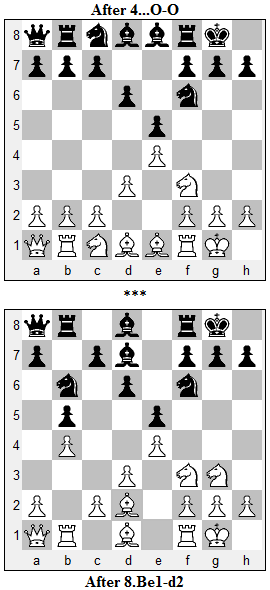My only loss was to the eventual winner, who had also won the 2011 event where he was the victor in the game I featured in the 'Positional Handicap' post. The chess960 wheel of fortune gave me the Black pieces in SP489 QRNBBKNR. Our first moves were 1.e4 e5 2.Nf3 d6 3.O-O Nf6 4.d3 O-O, with perfect symmetry, as shown in the top diagram.

Now my opponent played 5.Ne2, heading with the Knight to g3, and I took stock of the position. A Queen in the corner nearly always requires special consideration to determine how the piece will get into the game. I looked at 5...a5, decided that it didn't do enough besides letting the Queen out, and finally settled on 5...b5. That move stops d3-d4, and prepares ...Nb6, thereby breaking the symmetry. There are two themes in the works -- (1) minor piece development, and (2) Queenside expansion -- where I could alternate between the two.
The game continued 6.Ng3 Bd7 7.b4 Nb6 8.Bd2, reaching the bottom diagram. With the exception of the Knights that started on the c-file, the position is still symmetric. My Knight had come into the game in one move, while White's Knight had taken two moves, but White's Knight seemed better placed. I decided to continue straightforward development, hoping to capitalize on my extra tempo: 8...Be7 9.Re1 Qb7.
Now White played a break that I had underestimated, 10.a4!. After 10...Nxa4 11.c4 a6 12.d4!, he had a space advantage and the better position. If Black swaps Pawns on d4, a White Knight gets to f5, when Black is in real trouble. I eventually gave up the Pawn on e5, and exchanged down to a position where White had only a 4-3 Pawn advantage on the Kingside plus all major pieces and a Knight against my Bishop. It was enough to win the game.
One of the advantages of SchemingMind is that all games are played to a conclusion. There are no adjudications. I learned that White's small material advantage supported by a Knight was very tricky to defend against.

No comments:
Post a Comment